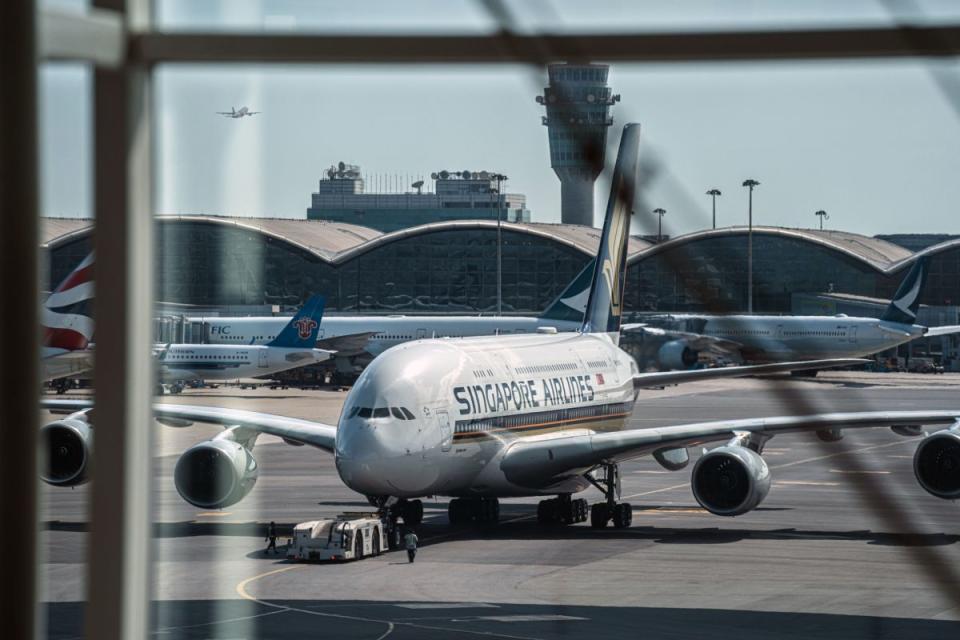UOB Kay Hian lowers SIA’s target price to $6.44 as August’s operation data disappointed

UOB Kay Hian believes SIA’s profitability has likely peaked and its earnings performance ahead is “due for normalisation”.
UOB Kay Hian analyst Roy Chen is maintaining his “sell” call on Singapore Airlines (SIA) C6L with a reduced target price of $6.44 from $6.82 previously, after the company released its operation data for the month of August.
Chen’s target price is based on 1.26x FY2025 P/B, or 1 standard deviation (s.d.) above the long-term historical mean P/B of 1.08x.
He believes that despite the airline’s excellent operating track record and strong balance sheet in comparison to regional peers, SIA’s profitability has likely peaked and its earnings performance ahead is “due for normalisation”.
SIA’s passenger capacity in August largely remained flat at 85.8% of pre-pandemic levels, slightly down from 86.1% in July. Chen notes that this is slightly behind his projected 87%.
The airline’s passenger load factor similarly showed a dip of 1.6 percentage points (ppt) m-o-m to 88.2%, down from 89.8% in the previous month.
“As a result of the flat passenger capacity and lower passenger load factors, [SIA’s] passengre load declined 2.1% m-o-m in August,” notes the analyst.
Meanwhile, cargo capacity also remained flat m-o-m at 88.9% of pre-pandemic levels.
Cargo load factor stood at 51.2% in August, down 1.2 ppt m-o-m or 3.0 ppt y-o-y, whilst cargo load declined 2.7% m-o-m but was comparatively up 0.2% y-o-y.
In his report dated Sept 19, Chen also notes that the airline’s cargo load factor may be affected by the subdued global trade outlook in the near term with the global manufacturing product and manufacturing information (PMI) and new export order sub-index remaining in contractionary territory at 49.0 and 47.0 respectively.
On a positive note, Chen observes that SIA resumed services to Busan, South Korea whilst Scoot resumed services to Nanchang, China, taking the company’s total passenger network to cover 119 destinations as compared to 137 destinations pre-pandemic.
However, the global jet fuel price index has seen a sharp rise of over 40% since end-June, which has been driven by rising air travel demand against a more constrained fuel supply.
Chen notes that due to the advanced booking nature of air ticket sales, the airlines’ near-term profitability is “likely to take a hit”, as the airfare levels of sold tickets would have been fixed but operating cost would still be “affected by the upswing” of jet fuel cost, as long as the airline has not fully hedged its jet fuel consumption.
He points out that SIA has hedged about 40% of its projected fuel consumption for the rest of FY2024.
Chen understands that the medium-to-long term impact of jet fuel price is more difficult to quantify, as it depends on if and by how much airlines are able to pass down the incremental fuel costs to end-customers.
“This, in turn, would be a function of the prevailing market conditions, including the capacity supply and demand dynamics and competition levels,” writes the analyst.
Taking into account SIA’s July to August operating data and factoring in recent jet fuel price movements as well as the company’s hedging position, Chen estimates SIA’s 2QFY2024 earnings (excluding forex gains/losses) to range between $420 million to $550 million.
He notes that this is lower than 1QFY2024’s reported net profit of $734 million and 2QFY2023’s reported net profit of $557 million.
The analyst therefore has cut his FY2024 net profit forecast by 4% to $3.17 billion, down from $3.29 billion, following his adjusted pax capacity and lord recovery projections, as well as factoring in the negative impact of the recent jump of jet fuel prices on SIA’s near-term earnings.
Chen continues: “Our FY2024 net profit forecast includes a one-off accounting gain of $1.11 billion from the planned Air India-Vistara merger, excluding which SIA’s FY2024 earnings forecast would have been $2.06 billion.”
Meanwhile, although the analyst expects SIA to sustain its dividend payout of 38 cents in FY2024 and yield of 5.6%, he reckons it is “likely not sustainable in the long run” as the company’s profitability normalises beyond FY2024.
Key risks noted by Chen include the weaker-than-expected macroeconomic environment dampening air travel and air cargo demand, and the faster-than-expected catching up of competition.
As at 12.35pm, shares in SIA are trading at 11 cents lower or 1.62% down at $6.69.
See Also:
Click here to stay updated with the Latest Business & Investment News in Singapore
UOB Kay Hian ups UMS’s TP to $1.56 after its key customer raises its earnings guidance
RHB keeps 'overweight' on grocery retailers; picks Sheng Siong over DFI
SGX's near-term growth outlook could see downside risk, RHB maintains 'neutral'
Get in-depth insights from our expert contributors, and dive into financial and economic trends

 Yahoo Finance
Yahoo Finance 